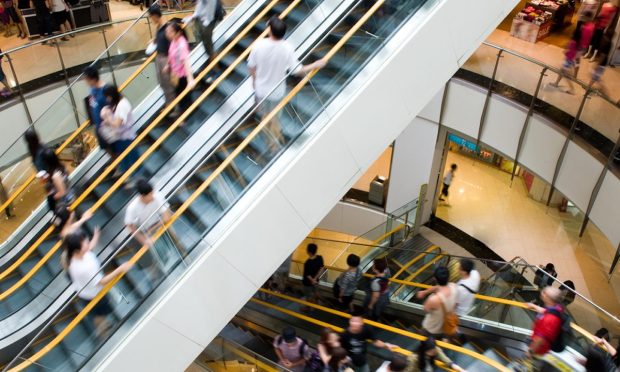Mall Sales Are Up, But Shopping Centers Still Have a Traffic Problem

Shopping centers around the country are beginning to fill with holiday shoppers for the first time in two years, boosting spending at brick-and-mortar malls — but traffic remains below levels seen prior to the pandemic, something that executives hope will be solved when international travel resumes.
In separate earnings reports this week, both Tanger Factory Outlet Centers and Simon Property Group said sales at their properties were up compared to both 2019 and 2020. For Tanger, tenant sales reached an all-time high of $448 per square foot, an increase of more than 13% versus two years ago. Simon Property recorded an 11% increase in mall sales compared to two years ago and 43% year over year.
David Simon, president and CEO of Simon Property, said the company’s results are particularly impressive given the lack of international tourism, which drives significant revenue. Restrictions on international travel to the U.S. are expected to relax starting next week.
“We’ll see whether it has any impact this year, as I kind of doubt it,” Simon told analysts on a conference call. “But … we still think there’s another leg up if we get the international tourists we have seen for two, three years.”
Data from Placer.ai show that foot traffic was down 6.5% at indoor malls in September compared to 2019 and down 5.2% at outdoor malls. That’s a less steep decline than six months ago, when indoor mall foot traffic was down 21% and outdoor was down 8.4%, but it’s a fall nonetheless. In the past six months, only July has seen an increase in mall traffic — 1% for indoor shopping centers and 1.8% for outdoor.
Related news: Malls Try to Fill Vacancies With Experiences as Traffic Remains Down
Stephen Yalof, president and CEO of Tanger Factory Outlets, said that to solve the traffic problem, the company has focused on growing its food offerings with new sit-down, quick-serve and grab-and-go concepts, as well as the presence of entertainment stores, kiosks and other amenities aimed at driving more frequent and longer shopping trips.
“The customers appreciate the amenity of food, and it keeps the customers coming back more frequently, staying longer on-site when they do shop with us,” Yalof told analysts. “And obviously, both of those result in bigger spends from our shoppers.”
Looking Ahead
Yalof said Tanger’s portfolio occupancy has returned to pre-pandemic levels, at 94.3% as of Sept. 30, despite one million square feet becoming vacant due to the bankruptcies and brand restructurings that have occurred since early 2020.
Simon, on the other hand, said it’s “going to take a little bit of time” for Simon Property to reach pre-pandemic occupancy levels, and he declined to forecast when that might occur. Occupancy at Simon Property’s shopping centers was 92.8% in the third quarter.
“But I think what’s exciting is that when we’re talking to our folks, they’re seeing a tremendous amount of demand,” Simon said, adding that “it’s the high-end retailers, it’s the value-oriented retailers. So, we’re very pleased with what we’re seeing.”
Mastercard SpendingPulse has projected that department stores will have a 5.2% increase in sales compared to 2019 this holiday season, which the National Retail Federation (NRF) projects will see record-setting spending.
See also: NRF Says Holiday Retail Sales Will Set Records
Still, Steve Sadove, former Saks CEO and senior adviser at Mastercard, told Karen Webster in a recent interview that this holiday season will likely prove to be a test of the in-store experience. If consumers are satisfied with the service and selection at malls and brick-and-mortar retailers, they’ll likely go back even if they still shop online for certain items. Otherwise, physical retail could be in trouble.
“The fastest way to go into a declining trend is to not give a good consumer experience,” Sadove said. “You’re at that moment right now, and some are going to do it well and some aren’t going to do it well. And that’s going to affect how this plays out over the next six months to a year.”
Read more: Holiday 2021: Pent-up Consumer Demand, Test of In-Store Experience for Retailers
That may be easier said than done, however, as Simon noted that supply chain issues and the ongoing labor shortage are impacting many mall tenants.
“The increase in restaurant demand has been phenomenal, and that’s the area I worry most about — ultimately, whether the employment picture could slow that demand,” he said. “I don’t know right now, but it’s a concern.”
